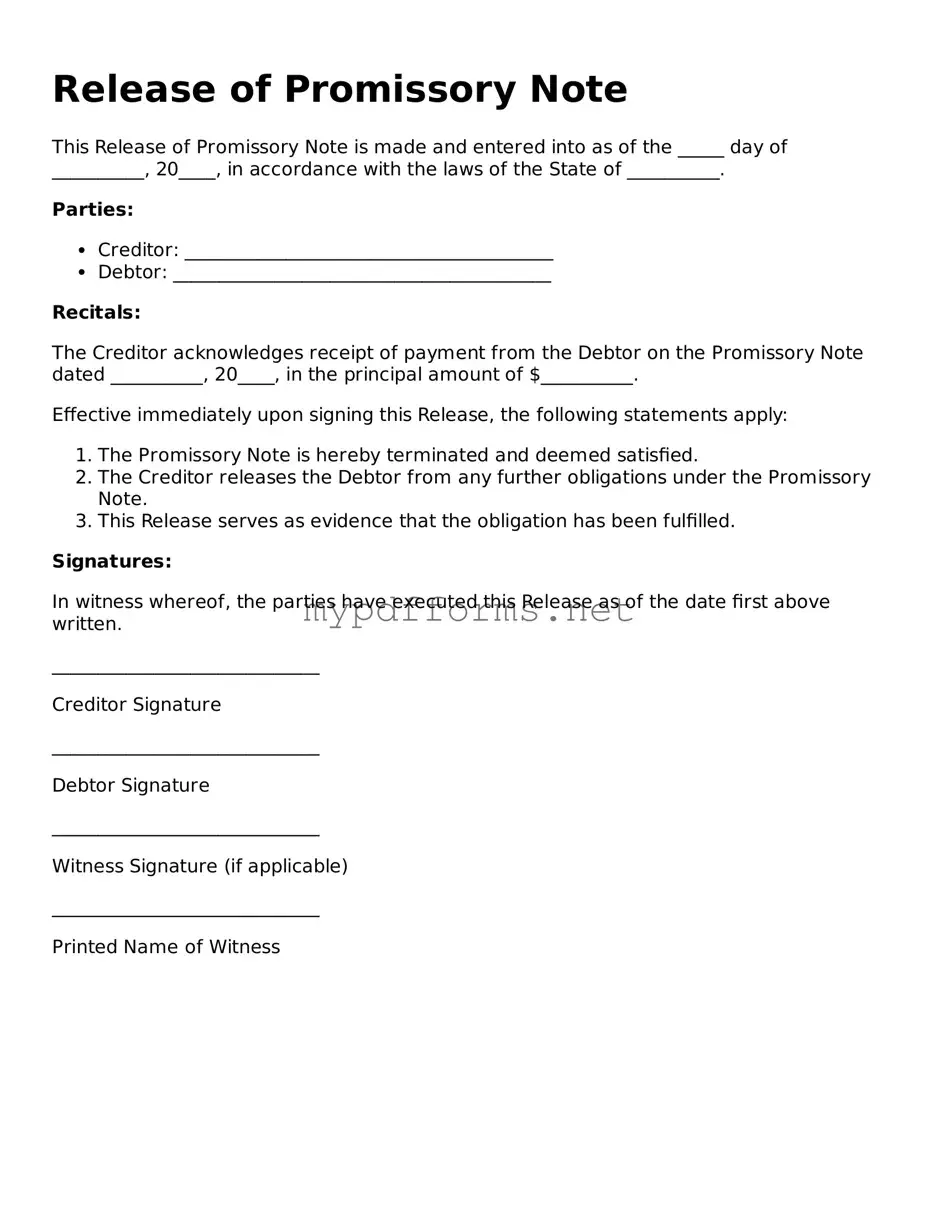The Release of Promissory Note form is similar to a Loan Agreement. A Loan Agreement is a document that outlines the terms and conditions under which a borrower receives funds from a lender. Like the Release of Promissory Note, it specifies the repayment terms and may include details about interest rates. Both documents serve to formalize the financial relationship between parties, ensuring clarity and protection for all involved.
Another document akin to the Release of Promissory Note is the Satisfaction of Mortgage. This form is used when a mortgage has been fully paid off, releasing the borrower from their obligation. Much like the Release of Promissory Note, it signifies the end of a financial obligation and provides proof that the borrower has fulfilled their responsibilities. Both documents aim to protect the interests of the parties by documenting the completion of financial agreements.
A Promissory Note itself is closely related to the Release of Promissory Note. The Promissory Note is the initial document that outlines the borrower's promise to repay the loan. The Release of Promissory Note follows once the borrower has fulfilled their obligation, effectively canceling the original promise. Both documents are integral to the lending process, with the first establishing the debt and the second confirming its resolution.
Similar to these documents is the Deed of Trust. A Deed of Trust secures a loan by transferring the title of the property to a trustee until the loan is repaid. Like the Release of Promissory Note, it involves a financial obligation and provides a method for lenders to protect their interests. Once the loan is satisfied, a reconveyance deed is issued, which parallels the release process in the Release of Promissory Note.
The Assignment of Mortgage also shares similarities with the Release of Promissory Note. This document transfers the lender's interest in a mortgage to another party. Both documents deal with the transfer of rights and responsibilities regarding financial obligations. When a mortgage is assigned, the original lender may issue a release to confirm that the borrower has met their obligations, much like the release associated with a promissory note.
The Loan Payoff Statement is another document that relates to the Release of Promissory Note. This statement details the total amount needed to pay off a loan, including any interest and fees. Once the borrower pays this amount, the lender issues a release, similar to the process following the execution of a Release of Promissory Note. Both documents provide clarity on the financial obligations and confirm the conclusion of the loan agreement.
A Release of Lien is also comparable to the Release of Promissory Note. A lien is a legal claim against a property until a debt is satisfied. When the debt is paid, a Release of Lien is issued, similar to how a Release of Promissory Note signifies the end of a borrower's obligations. Both documents protect the interests of the lender while providing assurance to the borrower that their debt has been cleared.
In navigating the complexities of financial agreements in New Jersey, it's essential to familiarize oneself with various documents, including those related to promissory notes. For a comprehensive understanding of these forms, you can refer to All New Jersey Forms, which provide valuable resources and templates to ensure compliance and clarity in any lending process.
Another document that can be compared is the Termination of Lease Agreement. This document formally ends a lease arrangement between a landlord and tenant. While it deals with rental agreements rather than loans, both documents signify the conclusion of a financial relationship and the fulfillment of obligations. The Release of Promissory Note and the Termination of Lease Agreement provide clarity and closure for both parties involved.
Lastly, a Settlement Agreement bears similarities to the Release of Promissory Note. A Settlement Agreement resolves disputes between parties, often involving financial compensation. Once the terms are met, a release is issued, confirming that the obligations have been fulfilled. Both documents aim to formalize the end of financial responsibilities and provide legal protection to the parties involved.
